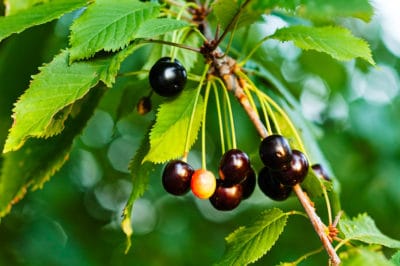Characteristics of Black Cherry Leaves
Like other species of cherry, black cherry has alternate leaves which grow staggered from one another on the branch. Black cherry leaves have a shiny upper surface and a dull green color on the underneath side, often with tiny hairs growing on the midrib.
If you look closely at the stalk of the leaf on black cherry trees, you will find one or two small glands at the base of the leaf. Leaf buds are approximately 1/8 to ¼ inch (3 to 6.3 mm) in length and have six dark, overlapping scales. The bud at the end of the branch is likely to be somewhat larger than other buds.
If you crush a black cherry leaf, it has a smell like bitter almonds. This odor is caused by prunasin, a compound containing hydrogen cyanide. This compound makes black cherry leaves poisonous, especially when they are wilted or damaged.
- The poison in black cherry leaf is of especial concern for livestock, although it is also poisonous for people.
- If you handle black cherry leaves, wash your hands afterwards, and keep animals away from fallen leaves.
- Rake up and dispose of black cherry leaves if they are in a field with grazing animals.
Other Facts about Black Cherry Trees
Black cherry is a wild cherry tree, naturally growing in many parts of the United States, Canada, Central, and South America. It is often found growing in open areas which have been logged, sprouting up from seeds distributed by wildlife.
Black cherry trees can be invasive due to their rapid growth rate and abundant fruit, which birds and other animals enjoy eating. The fruit of black cherry trees is also enjoyed by human beings, although it is not as sweet as sweet cherries. Black cherry is used for making jams and pies and added as a flavor in liqueur, soda, and ice cream.
Black cherry trees grow much larger than other species of cherry, reaching up to 60 feet (18.2 meters) in height and 30 feet (9.1 meters) across. This species grows in USDA climate zones 3 to 9, and while it prefers moist and fertile soil, it also grows in dry, less fertile growing conditions.
The bark of black cherry trees is different than other species of cherry, having a flaky look, which some people say resembles burned cornflakes.
